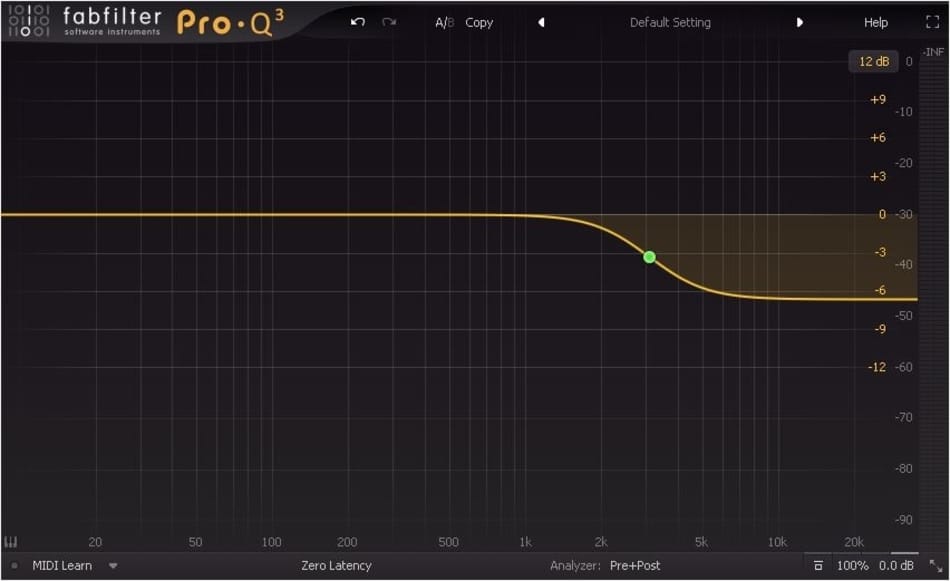
High Shelf & Low Shelf Explained
- EQ shelves are filters like the high and low pass filters
- There are 2 types of shelves – the high shelf and low shelf
- High shelf can be applied to the trembly high end of sound frequency, while low shelf to the bass bottoms
- Like the pass filters, shelves can be used for cuts, but not as drastic
- Unlike the pass filters, high and low shelf filters can be used for boosting
- In shelves, sound signals behind or before a set frequency are lowered or boosted by the same amount
- Low shelf is good for cuts and boosts on bass, solo acoustic guitar, strings, piano, and anything that needs more low end taming or power
- High shelf boosts can be used to add crispness to hats, cymbals, shakes and vocals
Knowing how to professionally use EQ in music mixing is the first step to producing radio ready songs in your home studio. It can be argued that equalizing is the most essential processing in mixing, because it is the tool for shaping the tone of your sounds. There is a lot to learn when it comes to Equalization: The frequency spectrum, the sub division of the spectrum (low, low-mid, mid, high-mid, and high) , the parameter controls, and the filter types; part of which the “shelves” we are focusing on belongs.
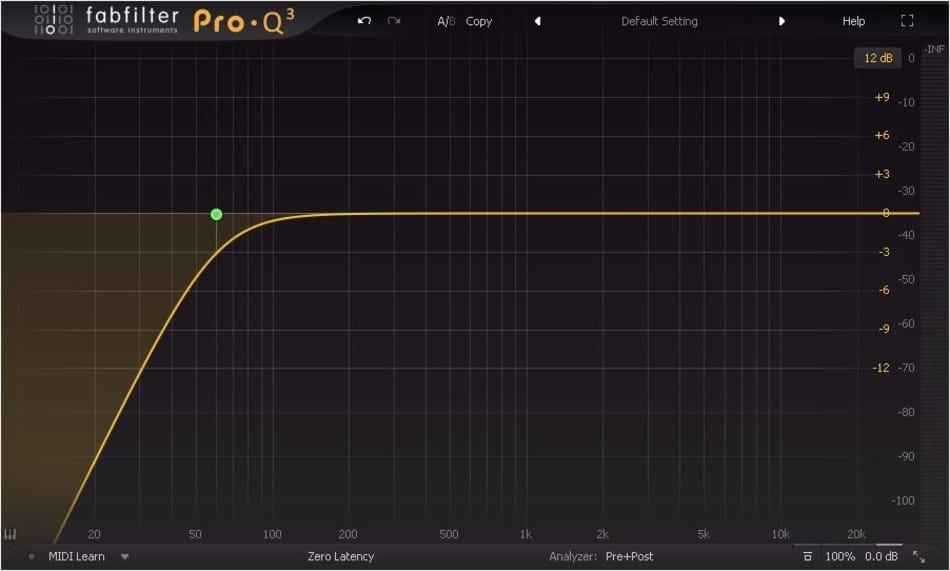
As a newbie, grasping the outlay of an EQ’s interface might be daunting at first, but you will understand it more by the end of this article. For this topic, we will be using a parametric EQ as pictured above for most illustrations. Worth noting is that the readings that run across the horizontal bottom denote the sound frequencies, and the values are in hertz(Hz) and kilohertz(kHz). You should also put in mind that 1000 hertz makes 1 kilohertz. Most equalizers cover frequencies running from 20Hz to 20KHz, which are the frequencies really perceivable by the human ears.
Often on the right vertical side of most parametric EQs are readings that denote the volume level which are measured in decibels (dB). Though some EQ may have them on the left side. Other essential features on the interface are the basic controls which are the gain, frequency selector, the “Q”(bandwidth), and the filter type selectors, which will be explained more later in the article. To get right into the main topic, let us first take a brief look at the various types of EQ filters.
Common Types Of Filters On Equalizers
There are various types of filters used in equalizing, but the commonly used ones are the bell, high pass filter (low cut), low pass filter (high cut), high shelf and low shelf. There are others like the band stop(notch), band pass, and tilt type filters, which are seldomly used except for peculiar purposes.The image below shows the various EQ filter types and their icons. The shelves’ icons look like a sideways laying two pronged fork. The prong-like ends signify they can be used for cuts and boosts. The directions they face denote the end of the spectrum they are to be used on. The left facing icon stands for low shelves, while the right facing one represents the high shelves.
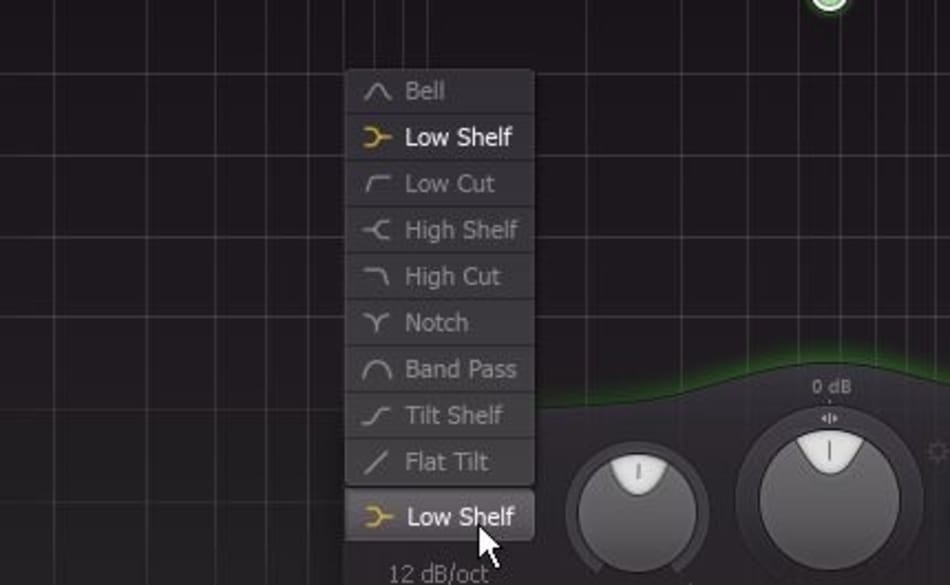
Due to their essence to this discussion, we are going to quickly touch on the high and low pass filters before moving on to the shelves.
High Pass Filter
The high pass filter is also known as low cut filter. The names are inherently self explanatory of its use. It is used to cut off sounds from the bassy low end of the frequency spectrum by letting only sounds above the cut-off point pass through to the output. Hence the cut is swept from left towards the right side of the interface. A high pass filter gets rid of sounds that fall behind the set frequency in a gradually descending volume slope. In the illustration image 1 above, the cut off point starts at the 60Hz region with about -2dB volume reduction, while the 20Hz region is reduced much more with volume level around -80dB. Any sound that falls after the point where the slope touches the floor is totally cut off. The cut off slope is adjustable in most EQs, while some have fixed values often set at default 12dB.
Low Pass Filter
The low pass filter does the same thing as the high pass, but on the upper part of the frequency spectrum. It is used to filter out the high frequencies allowing only the sounds below the cut off points to pass. Contrary to to high pass, the cut is made from the right side to the left.
The Shelf Filters
Like the pass filters, the shelve filters can serve the function of filtering out the high and low ends of a sound but in a less drastic way. Unlike the pass filters, rather than totally cutting off the sounds at the set frequency, the shelf filters attenuate the sounds that fall behind the set point by the same amount of volume.
Low Shelf Filter
The low shelf filter serves similar purpose as the low cut filter(high pass), but in a more subtle way. As explained above, it only reduces the volume of sound signals after the set frequency by desired amount rather than entirely removing them. This image below better explains the difference between its workings and that of a low cut filter.
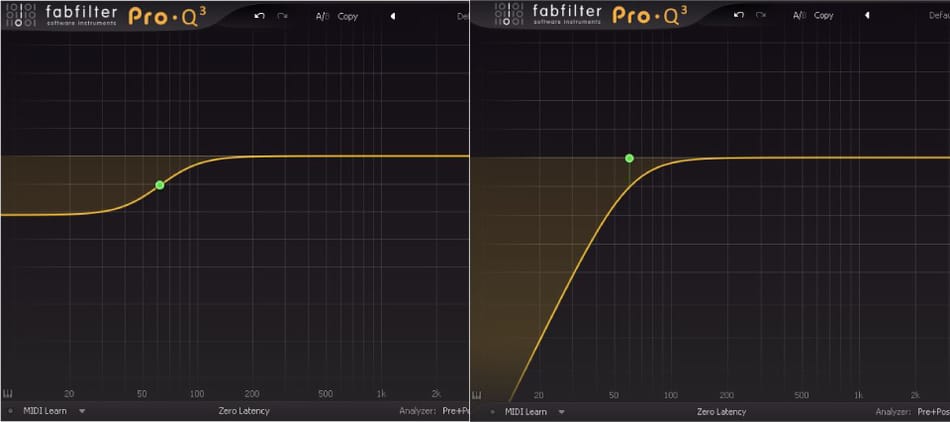
Aside from their use for filtering out unneeded frequencies, shelves can also be used in boost mode to add more of the desirable frequencies. Therefore in this case, a low shelf boost will increase the desired bottom frequencies by the same volume level from the set point.
High shelf filter
The high shelf filter does the same thing as the high cut filter(low pass), but in a subtle way like the low shelf. It can also be used in the boost mode to add more of the needed trebly top frequencies. The image below shows the difference between the high cut filter and high shelf filter in cutting mode.
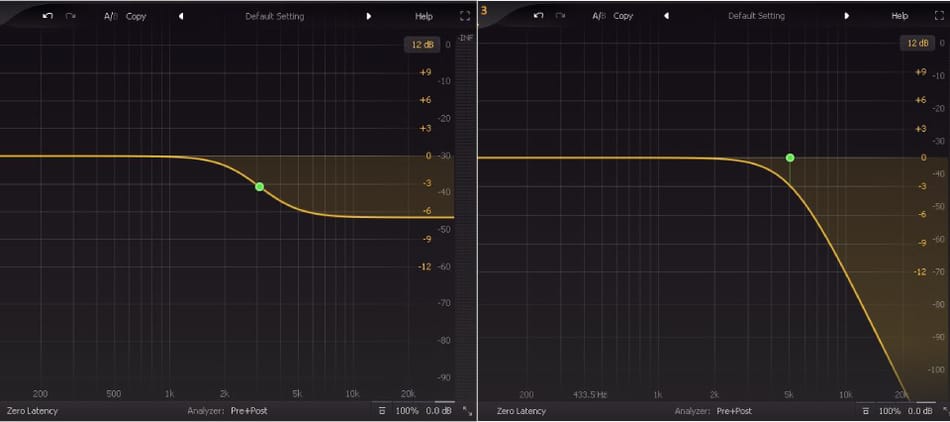
Altogether, we have a total of four possible shelf filter types. These are ; low shelf cut, low shelf boost, high shelf cut, and high shelf boost.
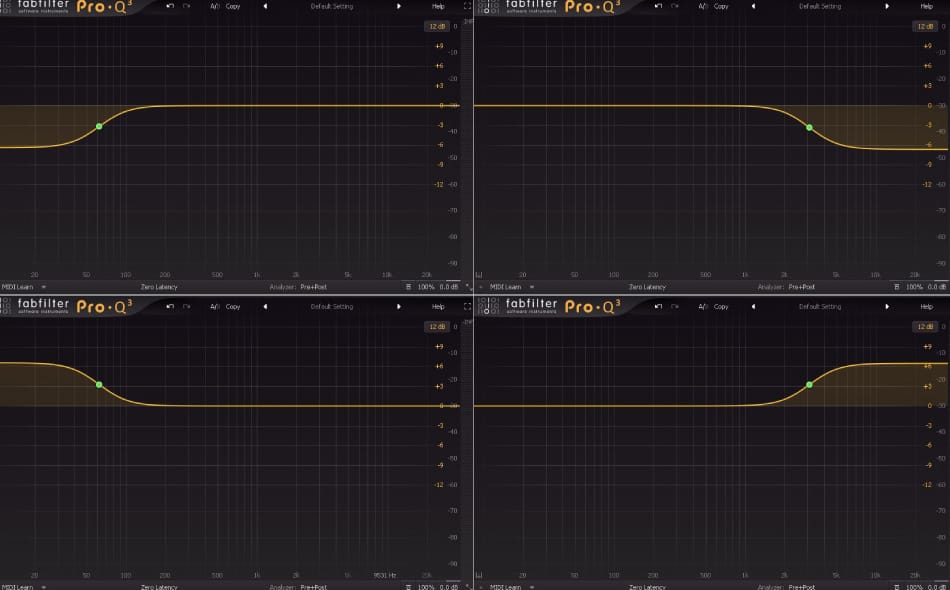
Control Parameters For Fine Tuning Shelf Filters
Gain
This knob or slider is used to adjust how much attenuation or boost to be added by a shelf. Besides using a knob, this parameter can be adjusted on most plugin parametric equalizers by clicking and dragging the shelf vertically up or down on the screen.
Q
This parameter controls how drastic or gradual the shelf transitions from the cut-off frequency to the highest or lowest point of the shelf, depending on if it is a boost or cut. Finely adjusting the can help make the boost or cut sound more natural.
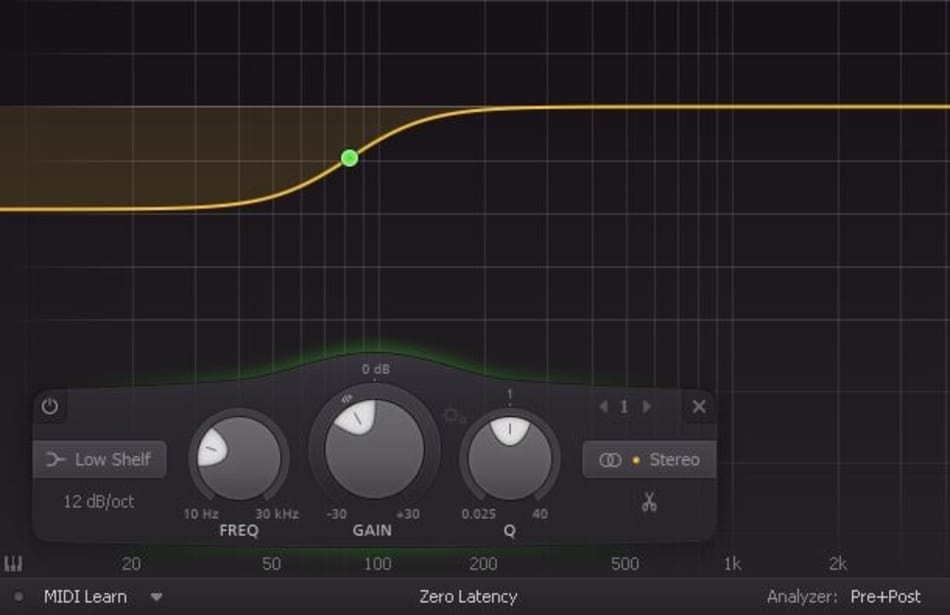
Frequency
This is used to select the frequency point at which the shelf will start cutting or boosting a sound. Like the gain, the shelving point can be selected by clicking and dragging the node horizontally along the frequency spectrum as an alternative to using a knob or slider.
Slope selector
Similar to high and low pass filters, the slope steepness can also be adjusted in shelf filters. Though the effect is less felt in shelves unlike in the pass filters. Some EQs also have fixed unadjustable shelf slope. However, having an adjustable slope will make room for finer adjustments, though it is hardly needed here unless you are making very steep cuts or high boosts.
When To Use Shelf Filters In A Mix
Shelves are special tools due to their feature of being very efficient in the “corner frequencies” (far highs and lows). Considering how subtle or extreme their adjustments can be and still be pleasing to the ears. They are the suitable tools for sculpting a better sound in those corners often more than a bell or pass filters. This is because of the even amount of boost or cut they make across all frequencies. Of course, the decision of whether to use a shelf filter over a bell or pass filter will be determined first by whether you are making a boost or a cut. If the aim is to boost, then automatically the pass filters are out of the options because they don’t do boosts but only cuts. This leaves you with the bell and the shelves.
Oftentimes the shelf is the better filter to reach for over a wide bell in boosting tasks, especially when it is a high boost to breathe some sheen or crispiness to a dull sound. Also if the task at hand is to get rid of a boomy bottom or harsh sounding highs, the subtlety of the low or high shelf cuts make them the right filter to use.
So the best way to making a good decision on which filter is suitable during a mixing session is to adopt the conventional practice of comparison. That is why almost every EQ plugin you will come across nowadays have the A-B comparison buttons. Some other EQ plug-ins like DMG Audio’s Equilibrium even take it up a notch by adding up to eight buttons (A to H).
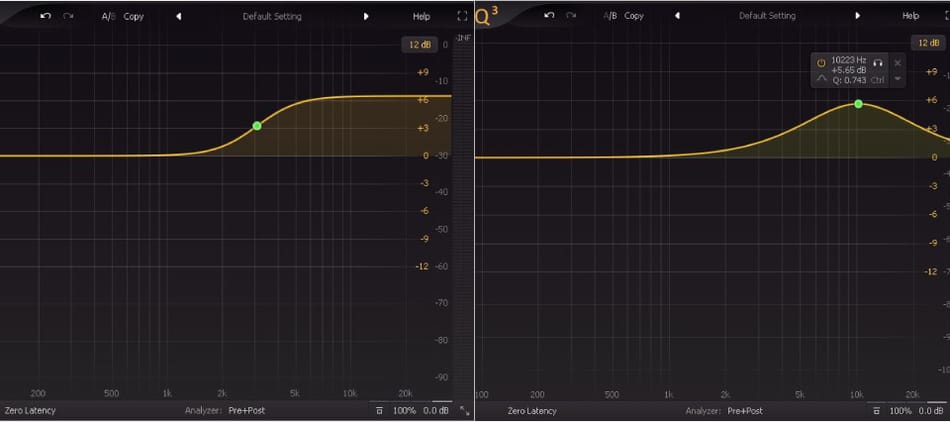
If you have not been using this plugin feature before, then you really need to start making use of it. It is not only useful in EQs, but in every other processing in mixing and mastering. Simply set up the the filter types on slots A and B, then keep switching between them to decide which one does a better job. This is where the golden rule of sound engineering comes into play – “train your ears”, so you can make better choices most of the time.
Real Life Applications Of Shelf Filters In Mixing
If you are mixing a bass guitar or synth bass that lacks bass in the bottom end, applying a low shelf boost at around 80Hz to 60Hz area can give you more heft than a bell boost. A solo acoustic guitar or strings can also use a little low shelf boost at the bottom to add some body to them. Contrarily, if the aim is to reduce some excess bottom end on a bass heavy instrument, rather than totally filtering it out with low cut filter, attenuating some of it with a low shelf cut can work a magic. Better yet, you can combine the low shelf with a slight bell notch at around 120 Hz to 250 Hz to clean things up more. Low shelf filters can also come in handy for use on a whole mix in some mastering sessions to boost weak lows or tame boomy lows as well.
On the other end of the spectrum, you can use high shelf boost on bland vocals to add some sparkles to to them. It can be also fantastic on trembly percussion like cymbals, tambourines, and hi-hats. Other times, a tad of high shelf boost on instruments like acoustic guitars and piano adds some presence that helps them to cut through the mix. High shelf can as well be used in a mastering situation to brighten up a dull mix. High shelf boosts should however be used in a conservative manner so as not to make things overtly harsh sounding.
That is about all you need to know on EQ shelf filters. The possibilities are endless. Just experiment more with things. With this knowledge, I hope you get to use them more in your home music production sessions. Have a nice time mixing!
Pingback: Audio Processing: Equalisation – Joe Miller's: Creative Blog
Pingback: How to Choose the Right Chest of Drawers For Your Dining Room – Buyfluo Xetine
Pingback: Different Types of EQ's and Their Uses, Somebody Call the Surgeon - Mixxed Blog